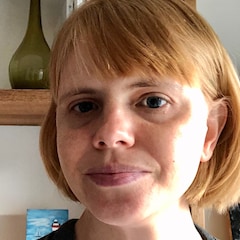Iwami Art Museum Celebrates Legendary Fashion Designer Hanae Mori
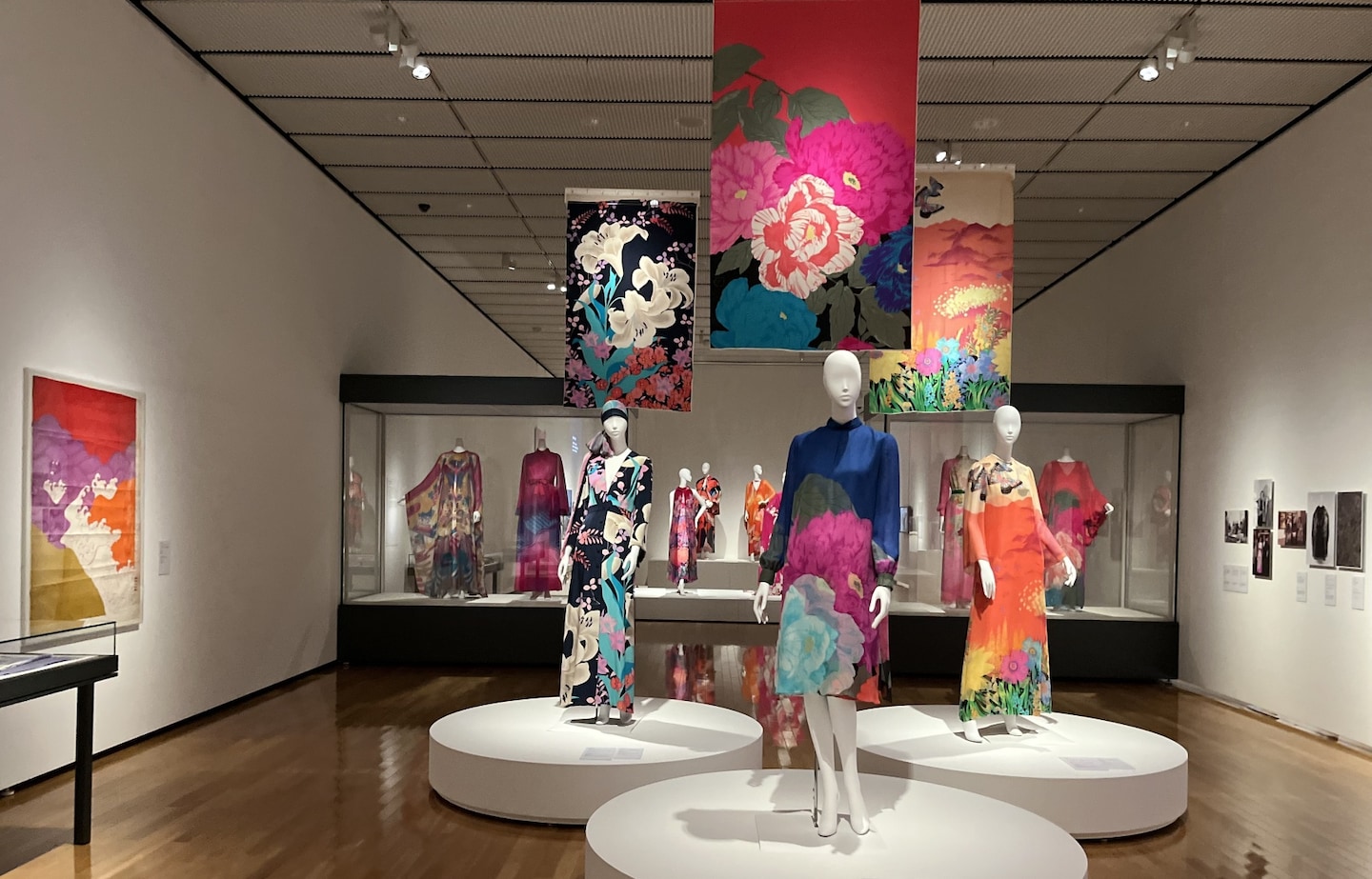
Iwami Art Museum in Masuda, Shimane surveys Mori’s groundbreaking career of more than 50 years. Her colorful dresses, created with innovative uses of fabric, bridged cultures of East and West. Photo: Jennifer Pastore.
The life and work of Hanae Mori, one of Japan’s most acclaimed fashion designers, is the focus of an extensive exhibition at Iwami Art Museum in the Shimane Arts Center (Grand Toit), located in the Shimane Prefecture city of Masuda. Jennifer Pastore visited this museum in the region where Mori was born and describes the show’s highlights.
By Jennifer PastoreDefining Postwar Womanhood with Style
A black and white photograph shows a young woman with a beaming smile standing before a window, her elbow resting on a stack of floral-patterned fabrics and a tape measure coiled around her hand. The energetic yet poised subject is Hanae Mori in her clothing boutique Hiyoshiya, near Shinjuku Station in the mid-1950s. Still in her twenties when she opened the shop, Mori was new to the Tokyo fashion scene but would go on to become a global phenomenon, leveraging her design skills and appreciation of Japanese culture to build a clothing empire that took not just the country, but the world by storm.
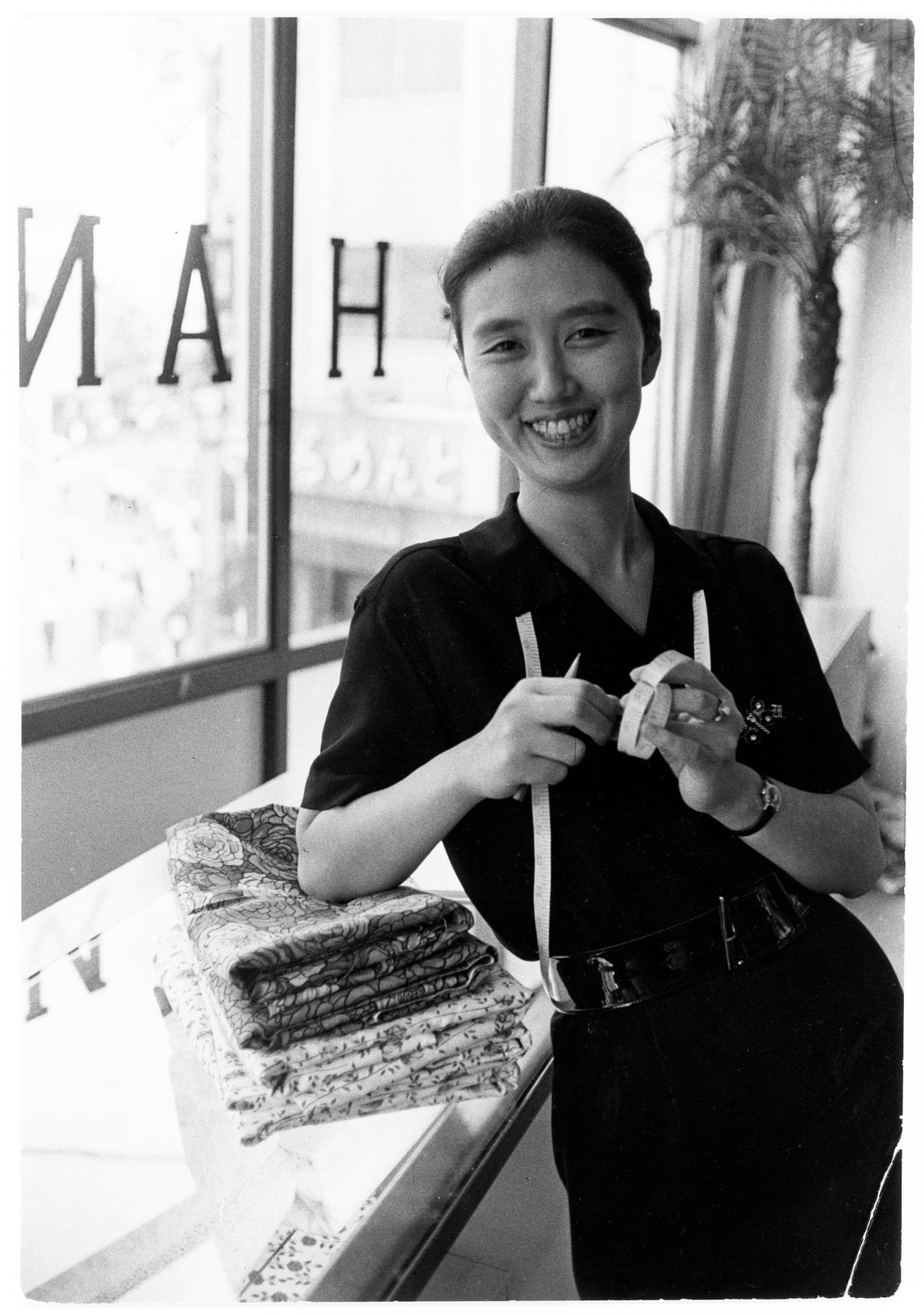
Mori at her first shop, Hiyoshiya, around the time it opened in the mid-’50s. Photo: Konosuke Ishii. Courtesy of Hanae Mori Office.
Mori established herself first in the domestic market, then abroad. She made her international debut in the United States with brightly colored and boldly patterned looks that defined an era of women’s clothing. She then grabbed attention in France, as the first Asian full member of the Paris Haute Couture Syndicate. Her achievements include designing uniforms for Japan Air Lines and the 1992 and 1994 Japan Olympic teams. She also designed the wedding gown for Princess Masako, dressed U.S. First Ladies, pioneered Japanese fashion news, travelled to China in the 1970s as the first officially invited clothing designer, and received awards such as Japan’s Order of Culture and France’s Legion of Honor.
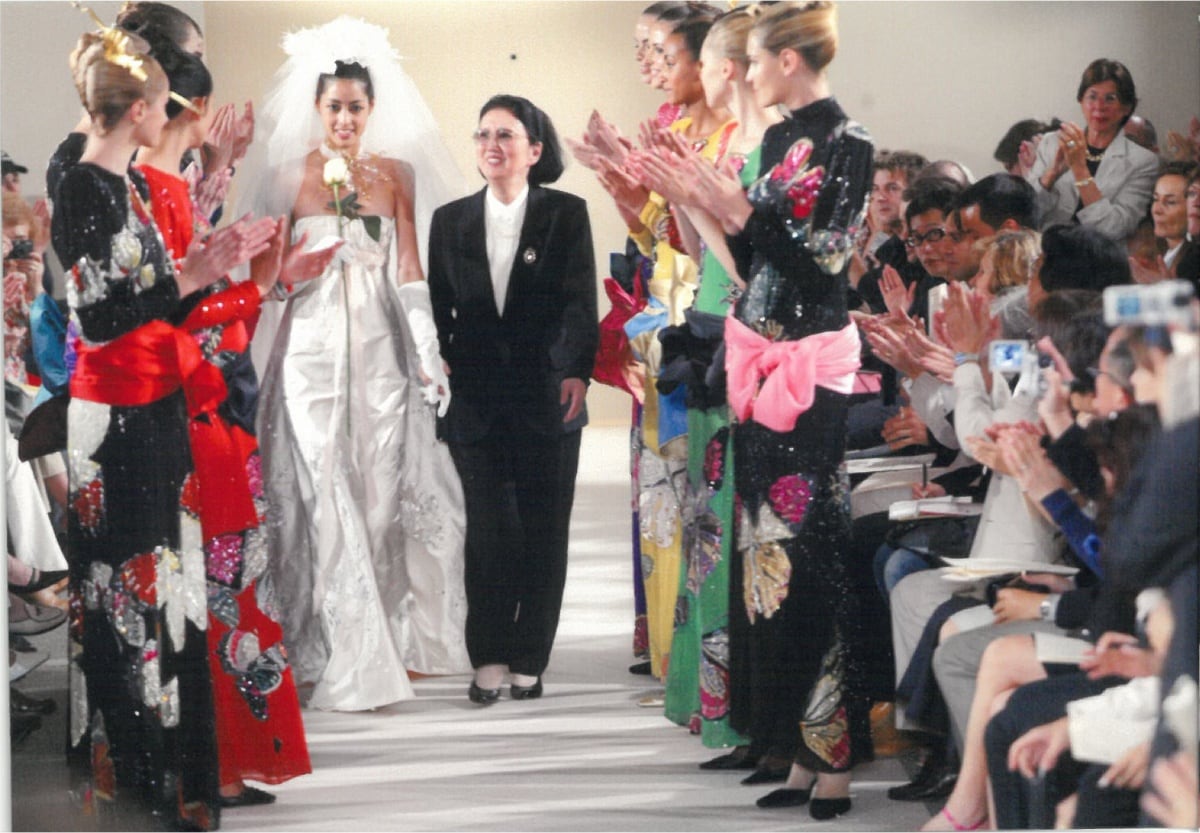
Hanae Mori Haute Couture 2004 Autumn/Winter Collection. Mori appears with her granddaughter, Izumi Mori, who wears a wedding dress in the finale of the show for Hanae’s final collection. Courtesy of Hanae Mori Office.
Hanae Mori Vital Type, now underway at the Iwami Art Museum in Mori’s native Shimane Prefecture, is the fashion designer’s first major retrospective since her death in 2022. The show takes its title from Mori’s term for a vibrant postwar lifestyle, personified by forward-looking women like herself, who sought fulfillment both inside and outside the home. Marking the centennial of her birth, it surveys her career in approximately 400 items with full English translations.
The exhibits include photographs and archival materials documenting her rise to fame, video footage showcasing her work and interviewing those who knew her, and numerous garments demonstrating her culture-bridging style. Highlights include a selection of her haute couture finery, dresses on loan from the Metropolitan Museum of Art in New York, newly rediscovered fabric designs and test prints, and collaborations with leading Japanese artists like photographer Ikko Narahara and graphic designer Ikko Tanaka.
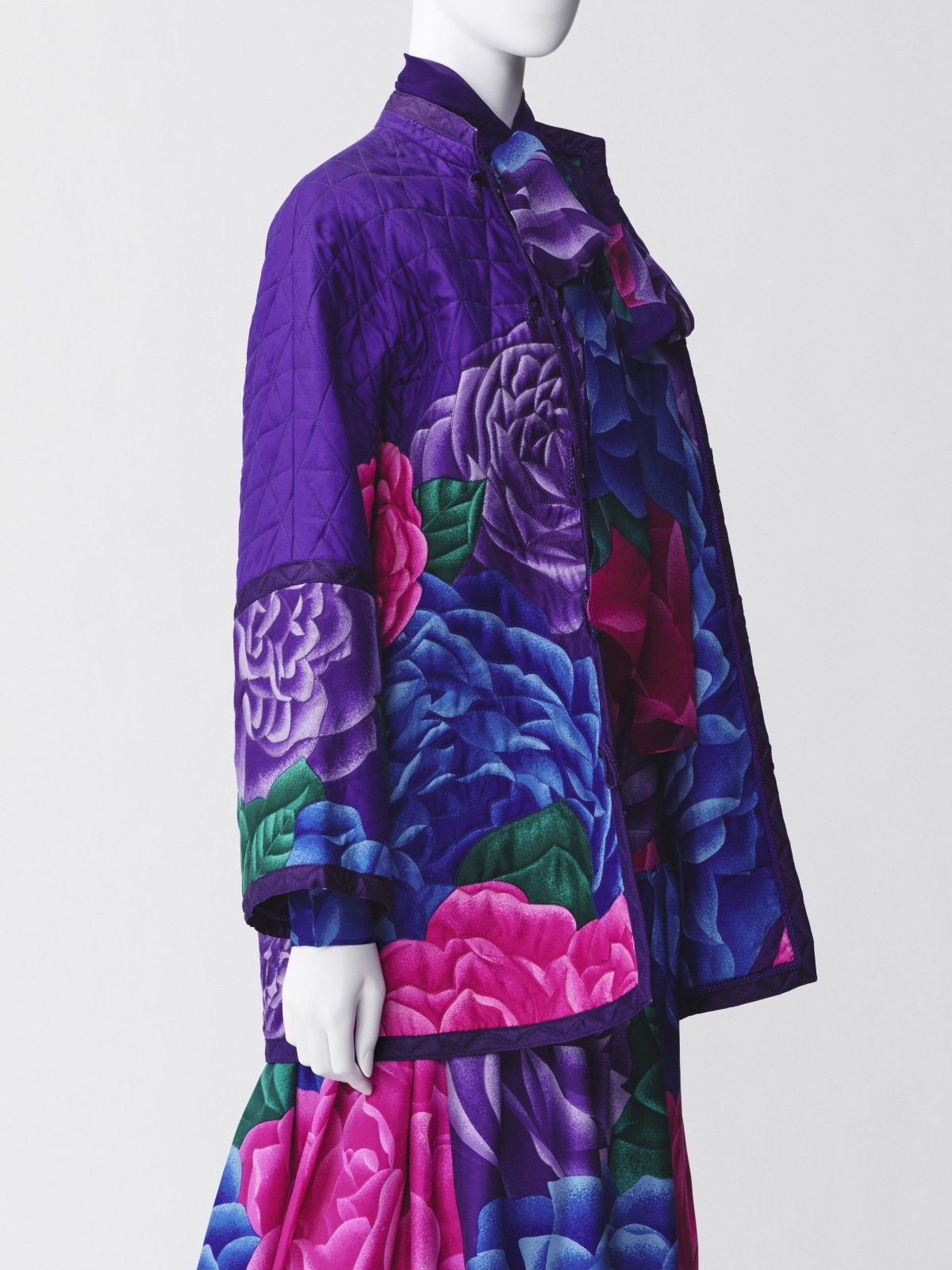
Hanae Mori, Evening ensemble, Autumn/Winter 1977, Hanae Mori Haute Couture. Photo: Masaki Ogawa.
Banner image for the Hanae Mori Vital Type exhibition.
From Shimane to Tokyo, from Tokyo to the World
Mori was born in 1926 in Muikaichi (now Yoshika) in the Iwami region of southwestern Honshu. In interviews she recalled her hometown as a place of unspoiled nature with blue skies and “a profusion of blooming flowers and fluttering butterflies.” She adopted the butterfly as the symbol of her personal brand, saying that it represented “a Japanese woman spreading her wings around the world.” Her family moved to Tokyo when she was in elementary school, but she did not lose touch with her roots. During the war years in the capital, she carried an amulet from Shimane’s Izumo Taisha Grand Shrine given to her by her father for protection.
After graduating university in 1947, she married textile entrepreneur Ken Mori and enrolled in dressmaking school. At the time, it was common for women to make clothes for their families, and her practical hobby flourished into a professional passion. According to Iwami Museum of Art Chief Curator Miki Nammoku, Mori pursued her career while grounding herself in a stable homelife, which she viewed as a foundation of her success.
The fashionable, made-to-order Western outfits in Mori’s Shinjuku shop caught the eyes of Tokyo film producers, who asked her to provide costumes for the silver screen. It is estimated that during her career she worked on over 200 films, with leading directors like Yasujiro Ozu, designing iconic garbs like Hawaiian shirts and character-defining dresses for female stars. The film industry’s demanding schedule spurred Mori to hone her skills and expand her operations. In an exhibition catalog essay for “Fashion in Japan: 1945–2020,” Iwami Art Museum Curator Risa Hirota speculates it may have been the resources Mori acquired through film costume work that gave her the confidence to enter the U.S. fashion market.
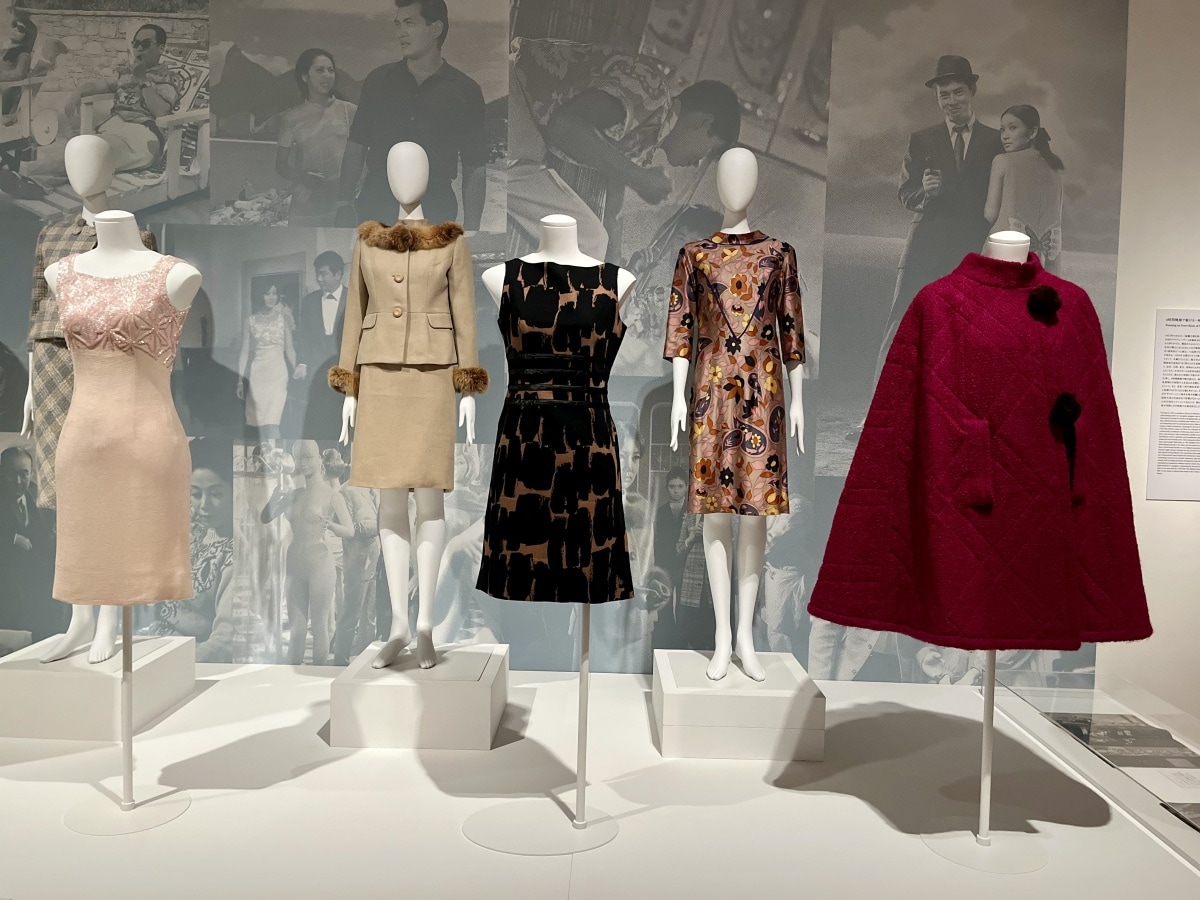
Film and television costumes by Mori. Front center: Day dress for Rub Out the Killers (1964), Iwami Art Museum; Far right: Poncho for the TBS Drama Banka (1966), Private collection. Photo: Jennifer Pastore.
Remaking Japan’s Image
A visit to New York in 1961 invigorated Mori’s ambitions. After seeing Japanese blouses sold cheaply in a department store basement due to their perceived inferior quality, she resolved to show the world the beauty and finesse of Japanese craftsmanship. She returned to Japan and spent three years researching fabrics. She then used this knowledge to create dress materials incorporating vivid colors and hand-drawn designs into obi sash textiles and chirimen crepe silk.
In 1965, she launched her first overseas collection, Miyabiyaka (meaning courtly elegance) in New York. Praised as a fusion of East and West, it earned her a place on the international stage. Vital Type presents an array of coats, dresses and other ensembles designed by Mori during this period. Adorned with dazzling colors and Japanese motifs like chrysanthemums and paulownia flowers, these items are exquisitely made with materials like Nishijin-ori silk from Kyoto, indigo-dyed Iyo-kasuri cotton from Shikoku, and chirimen from Shiga Prefecture originally used in cushions for Buddhist temples.
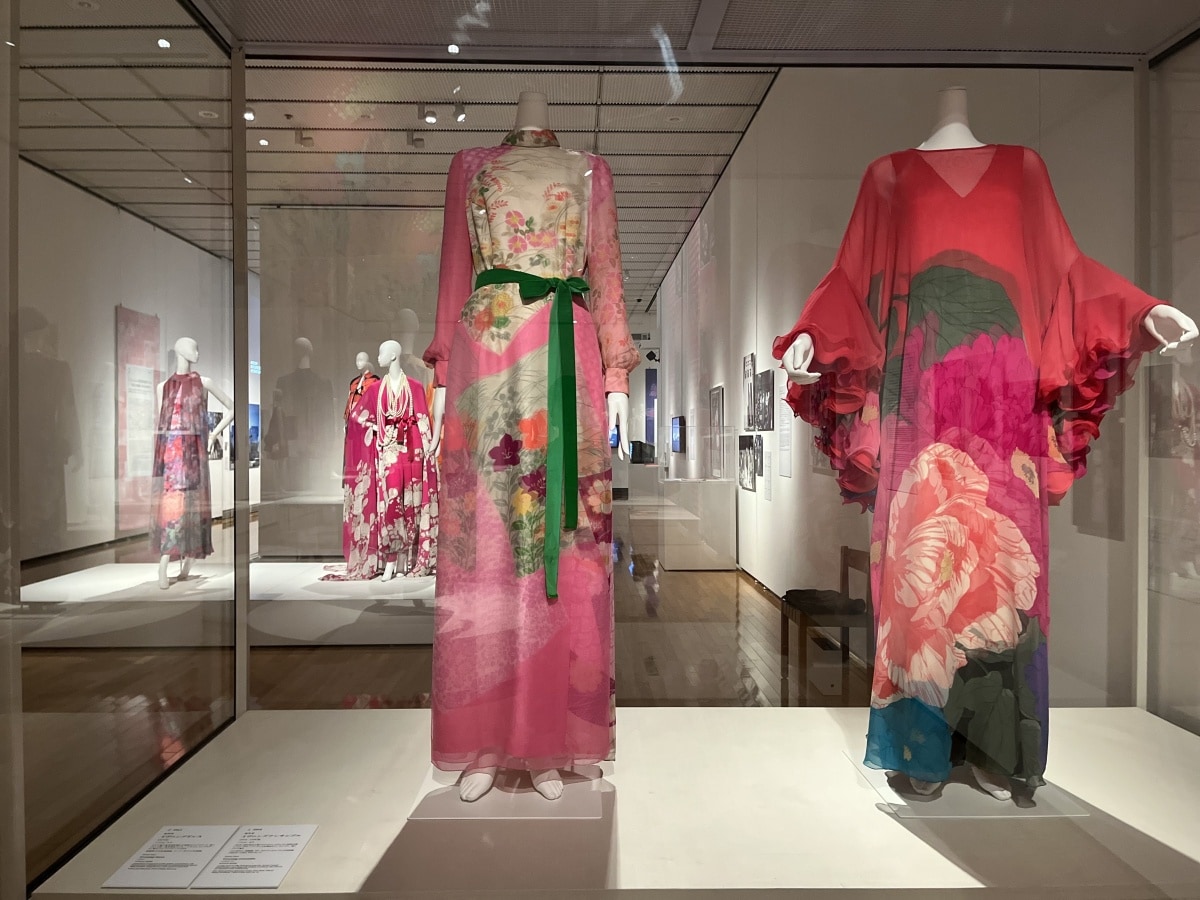
Left: Silk chiffon and habutae woven silk evening dress (1973), Iwami Art Museum; Right: Evening ensemble with silk twill dress, and matching silk chiffon evening dress (c. 1972–73), The Metropolitan Museum of Art, Gift of Diana Vreeland, 1984 (1984.607.6
Broadcasting Fashion’s Cultural Contributions
Mori’s designs were enthusiastically received in the West by fashion editors like Diana Vreeland of Vogue, whose red and pink peony gown with matching chiffon overdress gifted to the Met is on display. Fashion media became an important part of Mori’s career, as well. A section of the show is dedicated to her publications such as Ryuko Tsushin (Fashion News). Nammoku explained in an interview with All About Japan that Mori developed her multimedia network, which encompassed both TV and print, as a way of making fashion more a part of the cultural conversation: “Ryuko Tsushin helped drive the culture of an era” she says.
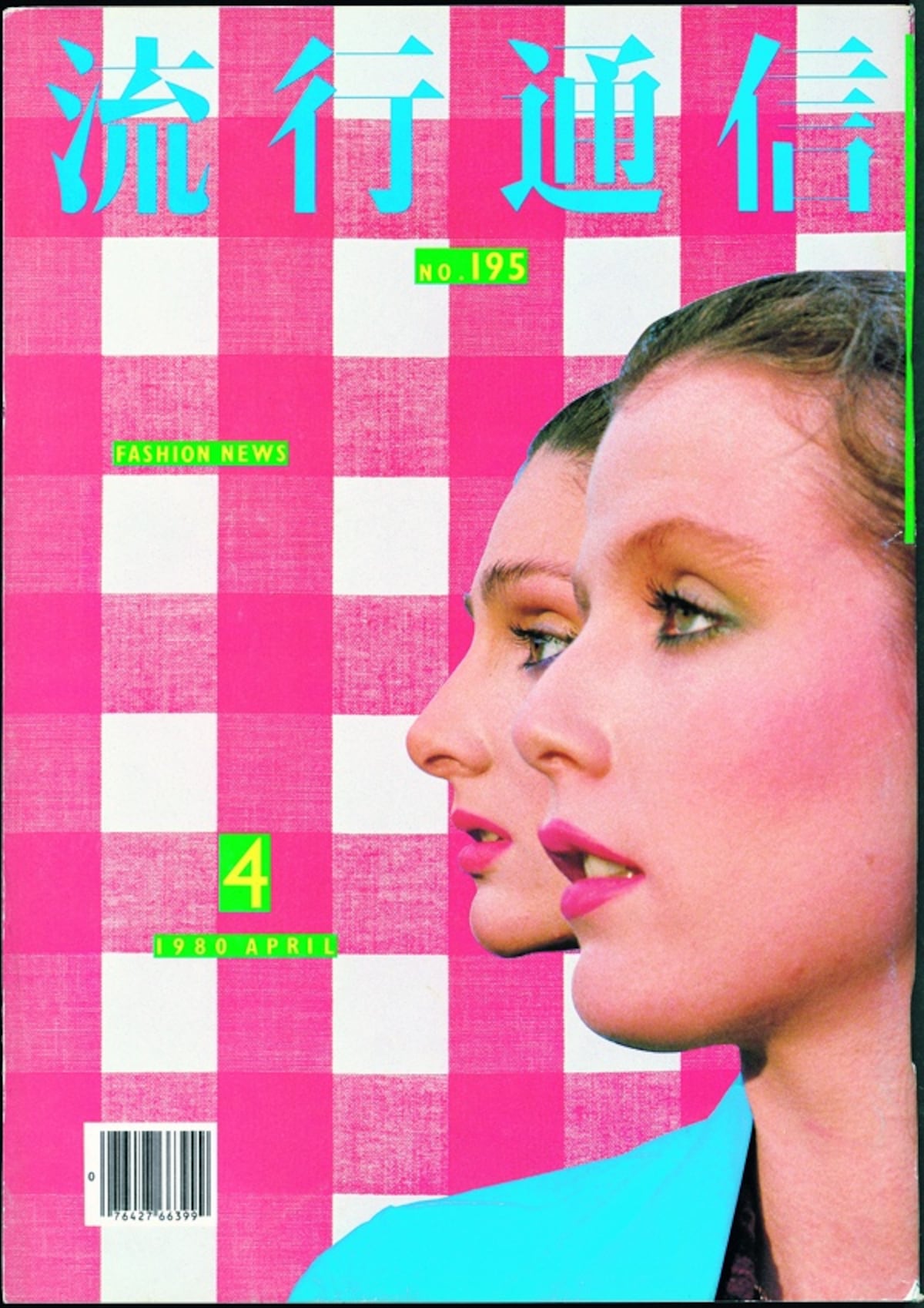
April 1980 (No. 195) edition of Mori’s magazine Ryuko Tsushin with art direction by leading graphic designer Tadanori Yokoo, Iwami Art Museum.
Haute Couture Collections
The exhibition’s top attraction is its room of haute couture by Mori, who in 1977 joined the syndicate of high-end fashion houses overseen by the French government. While her American clothes emphasized color and pattern, her European designs display a greater mastery of form, often using darker hues. Yet Mori continued to employ Japonisme motifs, seen in pieces like the black-and-white silk and chiffon Sumie (ink painting) evening dresses from her 1989 Spring/Summer collection. Printed with flowing kana script from the Edo period, these garments simultaneously evoke grace and strength––trademarks of Mori’s ongoing dialogues between Japanese culture and the world.
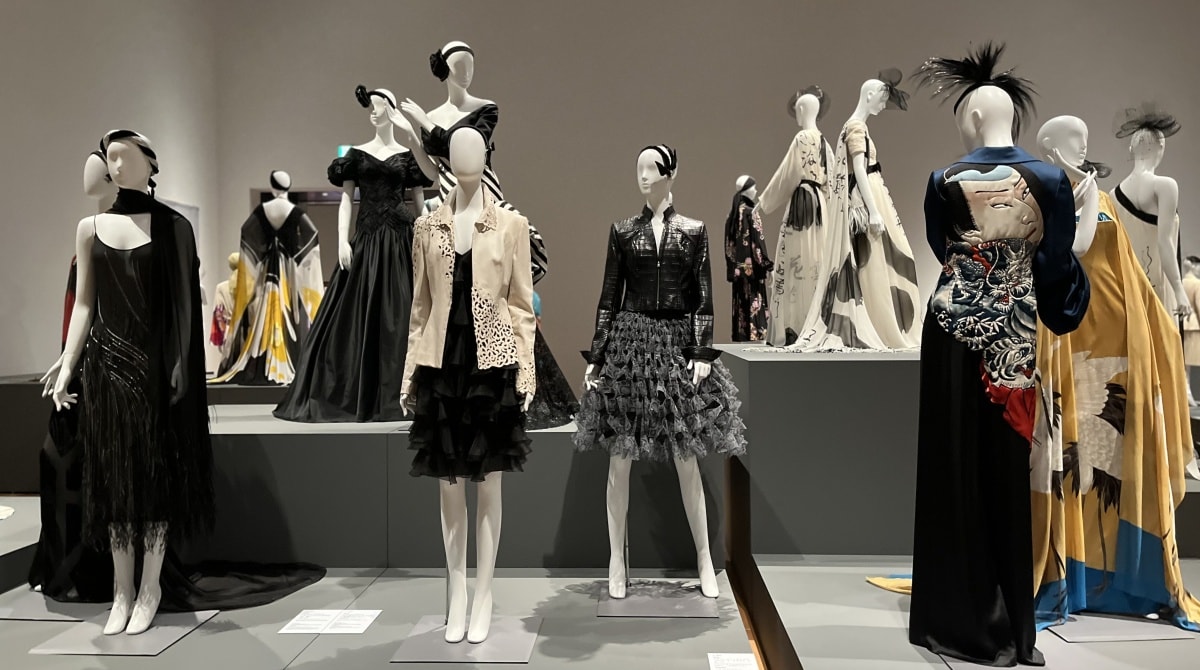
Installation view from Hanae Mori in France: Haute Couture section. Far right, front: “Deep sea-blue jumpsuit with kabuki actor” evening dress, Fall-Winter 2004. Photo: Jennifer Pastore.
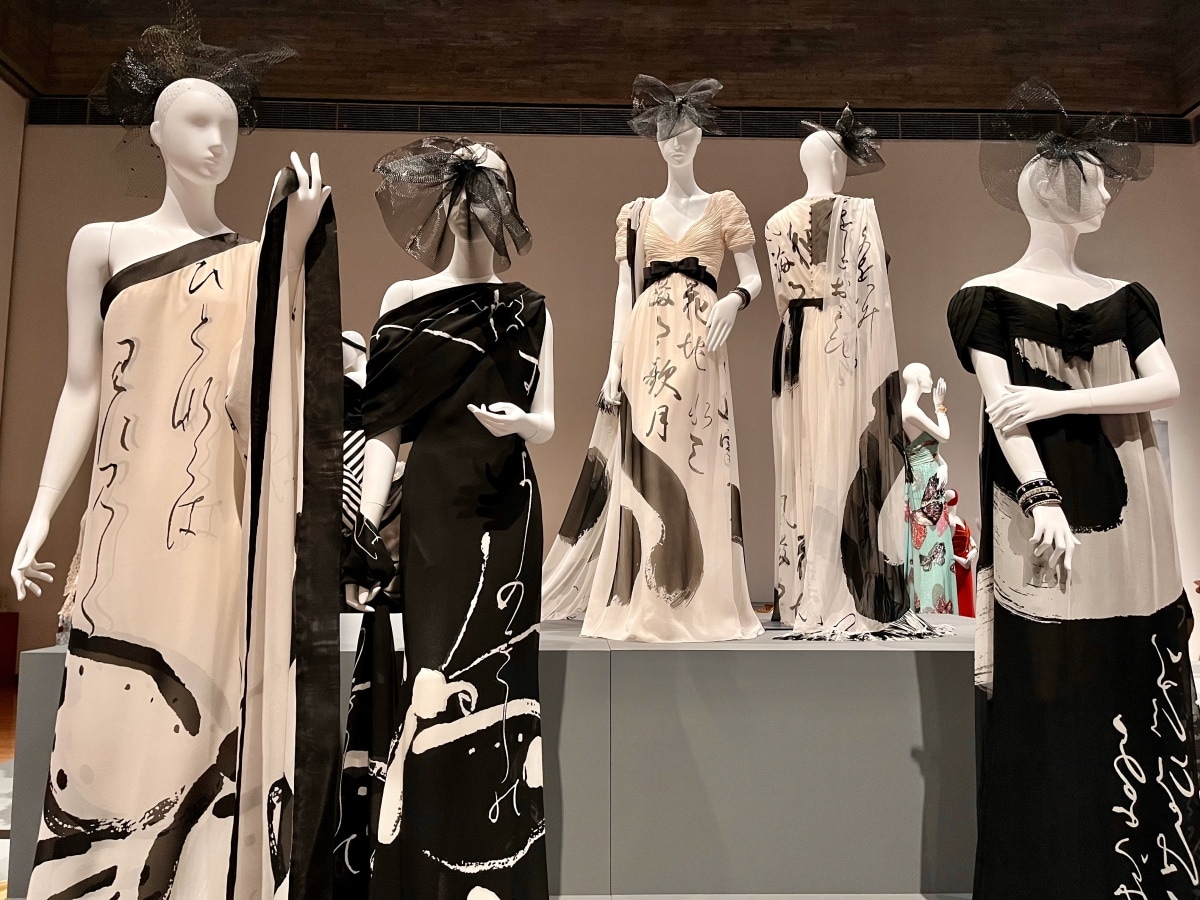
Evening dresses adorned with kana script, Hanae Mori in France: Haute Couture section installation view.
Photo: Jennifer Pastore.
Twenty Years Under the Grand Toit “Great Roof”
The Iwami Art Museum, part of the Shimane Arts Center Grand Toit cultural complex, is celebrating its 20th anniversary this year. Mori visited the site herself, and in her late years expressed a desire to see her fashions displayed in her home region. The center’s distinctive design by architect Hiroshi Naito, known for buildings like Kioi Seido in Tokyo, combines the art museum with a musical theater. A set of house-like structures surrounds an inner courtyard featuring a mirror-like reflecting pool. The roof and walls are covered in gleaming Sekishu tiles, an Iwami craft, which change color from reddish brown to gold and green depending on the light. The prominent sculptor Kiichi Sumikawa served as the center’s director until 2022, and his works (some permanently displayed) echo the building’s warm tones and sense of stately calm.
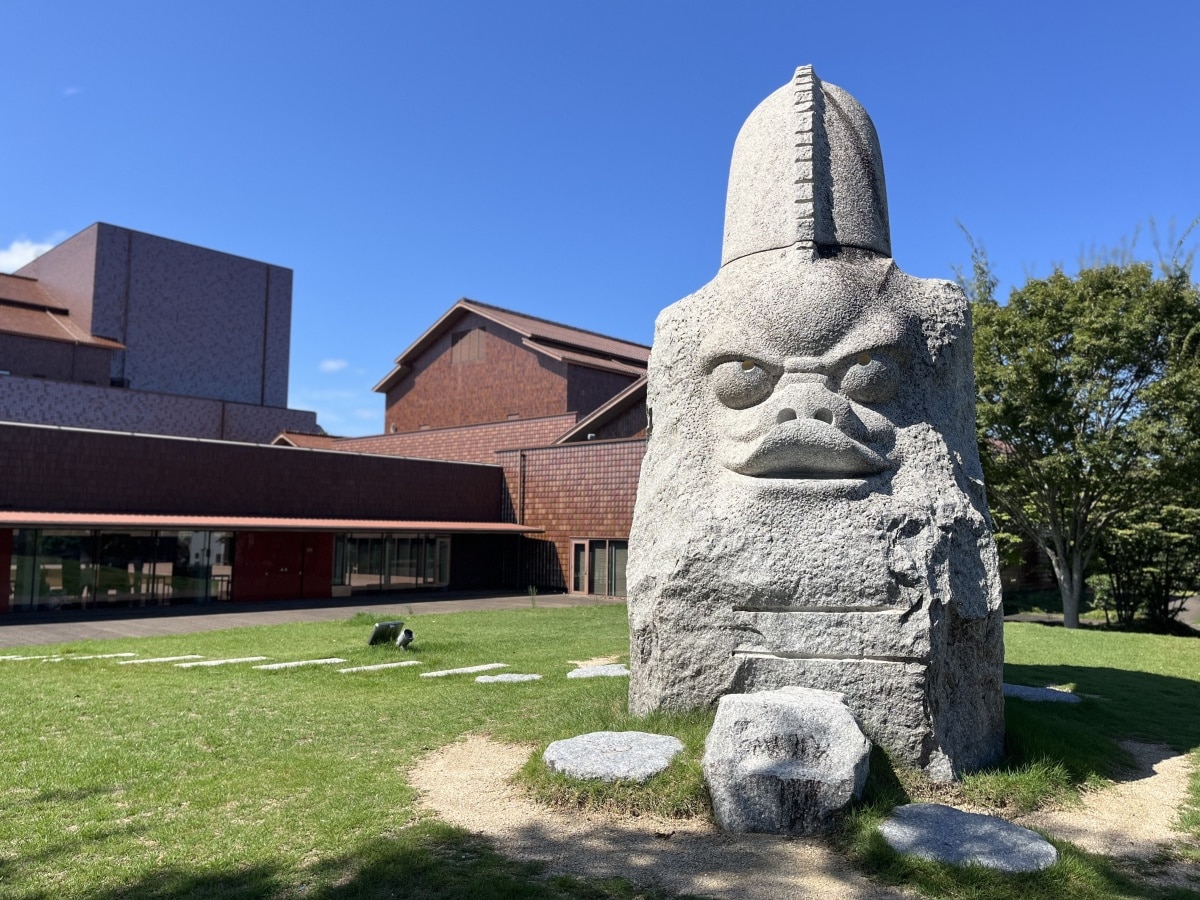
“Orochi” (2005), a granite sculpture by Kiichi Sumikawa. The orochi is a giant serpent appearing in the Iwami Kagura, a traditional dance conveying the mythology of the area. Photo: Jennifer Pastore.
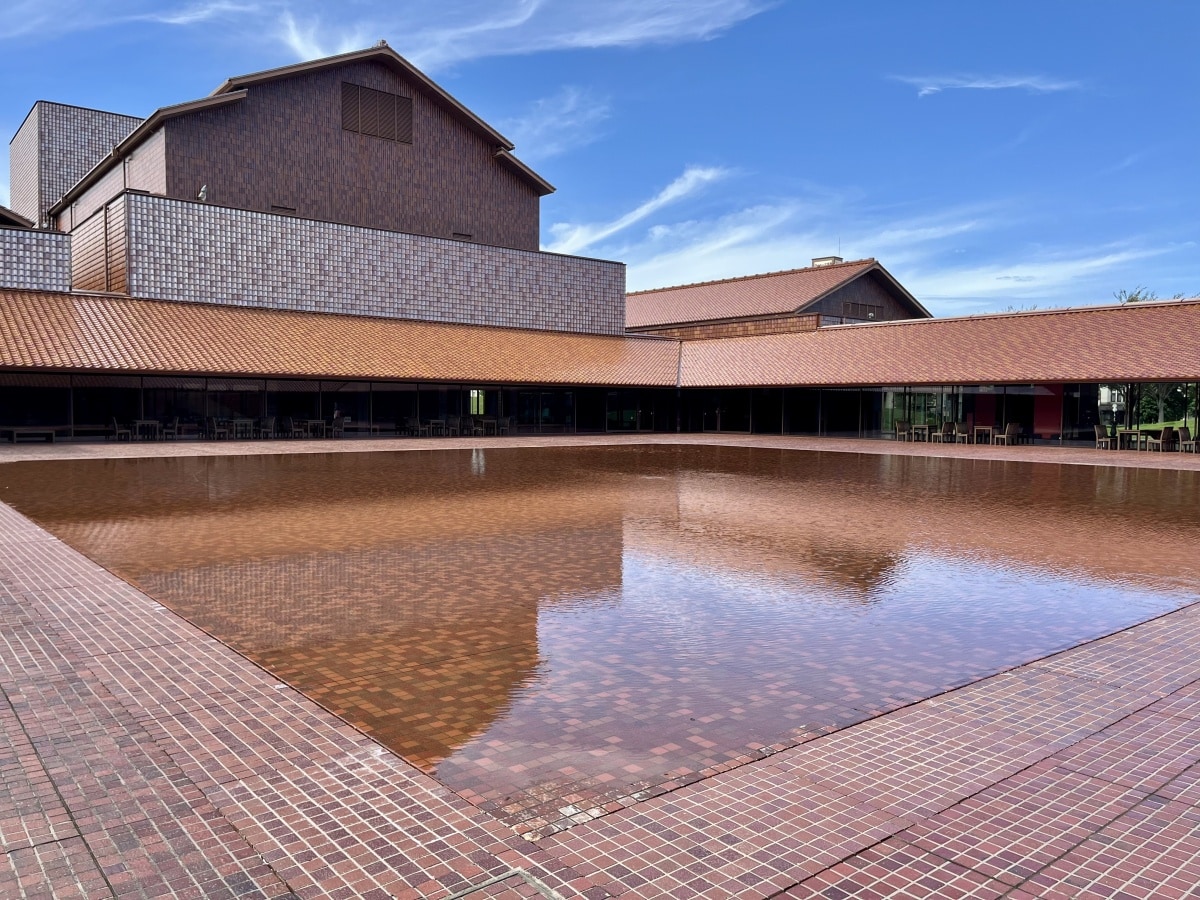
Grand Toit inner courtyard with reflecting pool. The Shimane Arts Center, designed by Hiroshi Naito, is constructed from Sekishu tiles. Photo: Jennifer Pastore.
Iwami Art Museum also showcases art and crafts difficult to find in other parts of Japan, such as nihonga classical Japanese paintings and Sekishu washi papermaking from the Iwami region. During the Vital Type exhibition, it will offer workshops and exclusive cultural tours exploring Mori’s ties to the area.
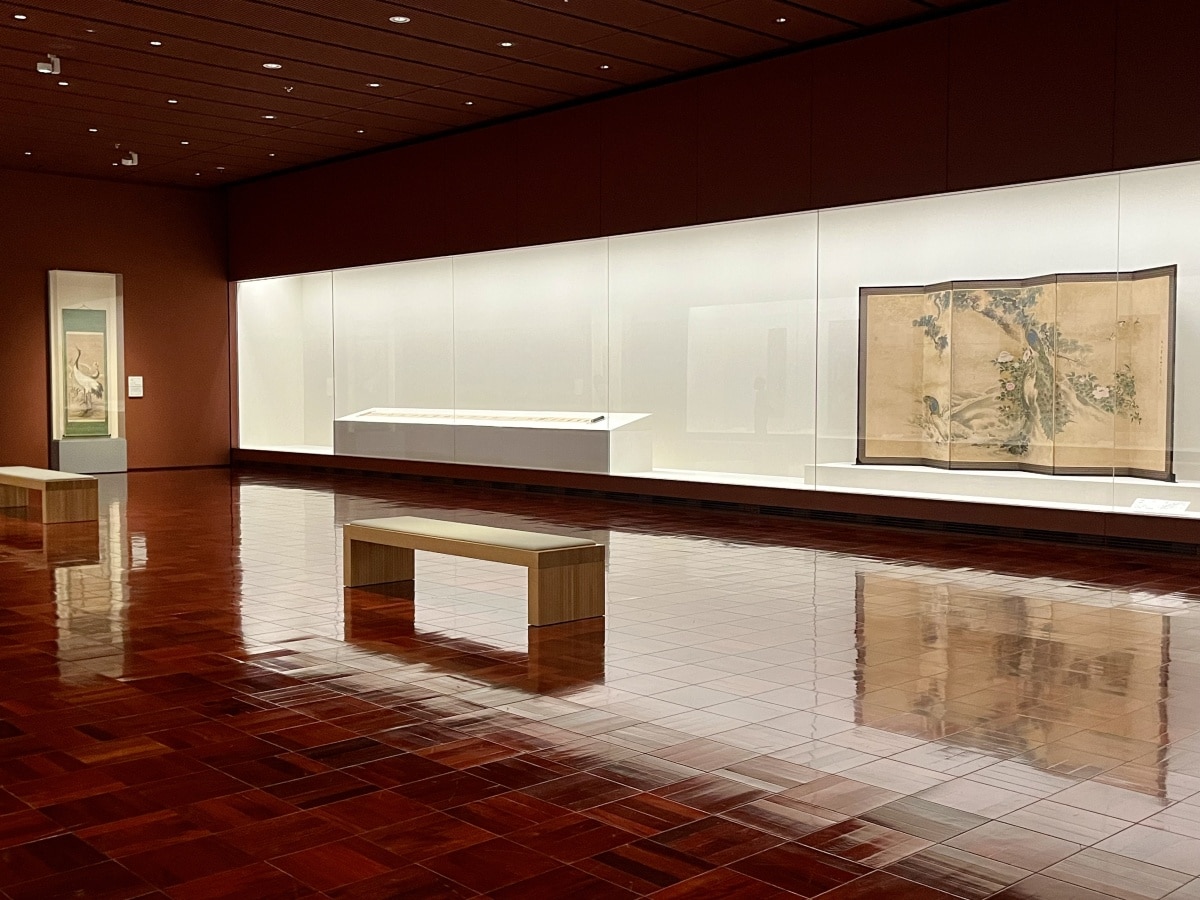
Edo-period nihonga by painters from the local Tsuwano domain. These 19th century works portray the natural world with styles and motifs similar to those used by Mori in her designs. Photo: Jennifer Pastore.
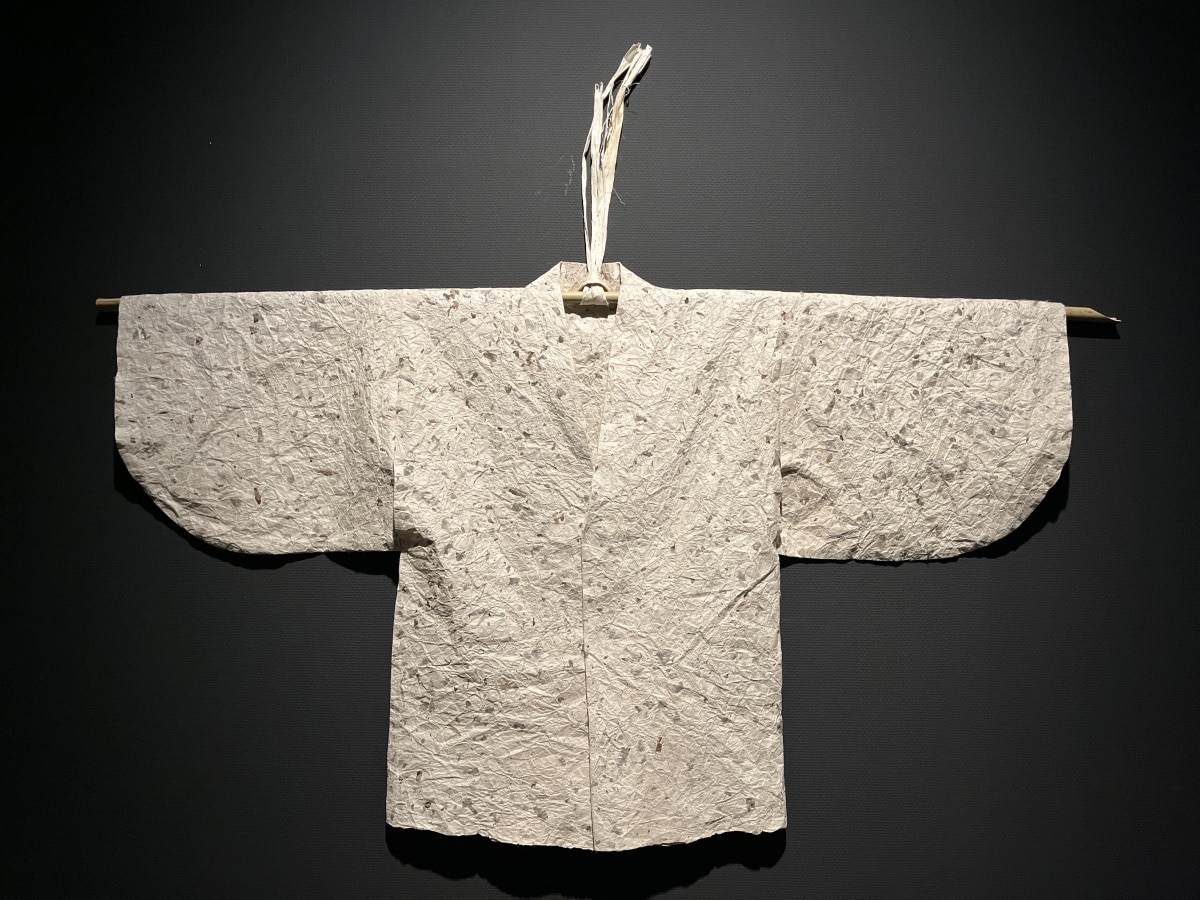
Handcrafted paper garment displayed in Sekishu Washi Paper and the Local Lifestyle of Iwami. (At Iwami Art Museum until Nov. 24, 2025). Yama-Kami Kamikoromo, created by COSMIC WONDER 2016, Artist’s Collection. Photo: Jennifer Pastore.
Hanae Mori Vital Type: The 100th Anniversary of Birth
September 20–December 1, 2025
Hours: 9:30–18:00 (last entry 17:30)
Iwami Art Museum
5-15 Ariake-cho, Masuda City, Shimane Prefecture 698-0022, Japan
+81-856-31-1860


